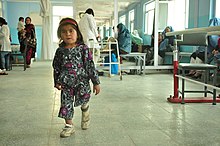
Back طول الساق غير المتكافئ Arabic Ayaq uzunluğunun fərqliyi Azerbaijani Beinlängendifferenz German Diferencia de longitud de las piernas Spanish Inégalité de longueur des membres inférieurs French Колченогость Russian Chênh lệch chiều dài hai chân Vietnamese
| Unequal leg length | |
|---|---|
 | |
| A girl with a congenital, structural difference in leg lengths walking in a clinic. | |
| Specialty | Rheumatology |
Unequal leg length (also termed leg length inequality, LLI or leg length discrepancy, LLD) is often a disabling condition where the legs are either different lengths (structurally), or appear to be different lengths, because of misalignment (functionally).
Unequal leg length with a small degree of difference is very common; small inequalities in leg length may affect 40%–70% of the human population. It has been estimated that at least 0.1% of the population have a difference greater than 20 mm (0.79 in). As of June 2024[update], that is approximately 8.1 million people total in the human population.[1]
- ^ Gurney, Burke (2002-04-01). "Leg length discrepancy". Gait & Posture. 15 (2): 195–206. doi:10.1016/S0966-6362(01)00148-5. ISSN 0966-6362. PMID 11869914.
LLD is a relatively common problem found in as many as 40 [1] to 70% [2] of the population. In a retrospective study, it was found that LLD of greater than 20 mm affects at least one in every 1000 people [3].
© MMXXIII Rich X Search. We shall prevail. All rights reserved. Rich X Search